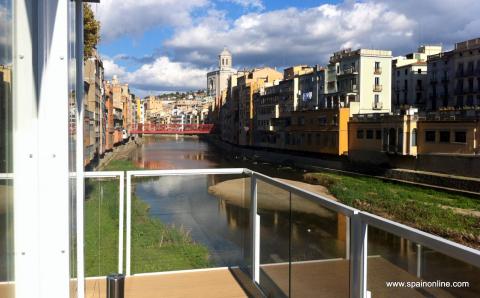Location in Spain:
Category:
All hotels/apartments of Girona - in a list | on a map >>>
Girona (as it is known in catalan, or "Gerona" in Castillian spanish) is the capital of the eponymous province in the autonomous region of Catalonia, which has its origins in the Roman city of Gerunda. This so-called "City of Four Rivers" has an historic quarter dominated by medieval buildings with Roman, Arabic and Hebrew architectural influences including the Gerona Cathedral, the Jewish quarter and the houses of Onar. Visitors can enjoy its excellent historical and cultural content in the walled-in area in the Força Vella.
The most popular and emblematic public space in Gerona is the Rambla de la Libertad, which was established in 1885 in the area that used to be the city's backbone since medieval times.
Girona's privileged geographical location between the Pyrenees Mountains and the Costa Brava means that visitors can enjoy lots of excursions to nearby towns and noteworthy natural spaces. In all these places, visitors will have the opportunity to sample the regional cuisine which combines seafood and produce from the mountains in its recipes.
Gerona Cathedral and the Jewish Quarter (el Call Jueu)
The important Pastors House (la Casa Pastors) is in Cathedral Square (Plaza de la Catedral). It is a Renaissance building that currently functions as the courthouse and Almshouse (la Pia Almoina). The Santa Maria Cathedral is also located in this square. It was built between the eleventh and eighteenth centuries and therefore incorporates four architectural styles: Romanesque, Gothic,
The houses of Onar
The houses suspended over the Onar river are a typical sight in Girona. The river divides the city into two parts and these very picturesque homes which have been built over the centuries on its banks look like a small Mediterranean city. All the walls facing the river are painted according to a strict colour palette. All of the medieval bridges that used to cross the river no longer exist and most of the buildings are contemporary.
Renaissance and Baroque.
El Call, the Jewish Quarter, lies within the crossroads of medieval alleys, where a small community lived until the late fifteenth century. It is one of the best preserved medieval villages in Europe. The Bonastruc Ça Porta Center is located here. It is believed to be the ancient synagogue which has now been converted into a school. The Montjuïc (or mountain of the Jews) is situated at the north side of the center.
In addition to other civil buildings such as Casa de l'Ardiaca and the Bishop's Palace, the Old Town is home to many important religious buildings, such as the Monastery of Sant Pere de Galligants or the Basilica of Sant Feliu.
The Costa Brava
The province of Girona has 214 kilometers of coastline (the famous and popular Costa Brava), stretching from Port Bou, to the north of the French border, and Blanes in the south, surrounded by El Maresme and El Montseny. It is located just 30 km. away from the capital and offers extraordinary landscapes, unique beaches with clear and clean waters, certified for their environmental quality and famous for the wonderful climate.
Beaches, coves, cliffs and forests are scattered amongst world famous places such as S'Agaró, Tossa de Mar, Begur, Cadaques, Lloret de Mar and Portlligat. The Costa Brava is one of the most popular tourist destinations in Spain.
Nature in the province of Girona
The Cap de Creus Natural Park, the l'Empordà marshes, the Medes Islands, and the coves at Begur, Palafrugell, Cadaqués and Tossa de Mar reflect the natural beauty of the region's landscape. Not forgetting the medieval villages of Pals, Peratallada and Púbol, among others, and the Santa Clotilde, Rosa and Marimurtra Pinya botanical gardens. With all these places to visit there is something to suit everyone.
The average annual temperature in the region is 16 degrees, with moderate rainfall, and there are 2,500 hours of sunshine each year illuminating all the historic-artistic vestiges just waiting to be discovered.
The Pyrenees
In the Pyrenees, as well as enjoying the breathtaking scenery, visitors can practice a wide range of mountain sports or go on cultural tours of the area's Romanesque architecture. The charming towns of Santa Pau, Besalú, Bas Hostalets Beget, etc, are located in the Cadi-Moixeró Nature Park, in the volcanic area of Garrotxa. There are also five ski resorts in the area (four for alpine skiing and Nordic skiing) so visitors can practice snow sports in the Girona Pyrenees. These resorts are:
If that was not enough, Andorra, with its huge resorts at Vallnord and Grandvalira, is only two hours from Girona capital.
Figueres
Figueres is the birthplace of the great artist Salvador Dalí. But it is also a very attractive town with shops, terraces, houses and lots of magic. The main visitor attraction is the Teatre Museu Dalí, where you can see works such as the Galarina, The Specter of Sex Appeal and the Leda Atomica. It exhibits surrealist installations such as the Rainy Taxi or the Mae West room, and shows Dali's recurring obsession with the figure of his wife Gala.
All hotels and apartments of Girona - in a list | on a map >>>
On the map:




























